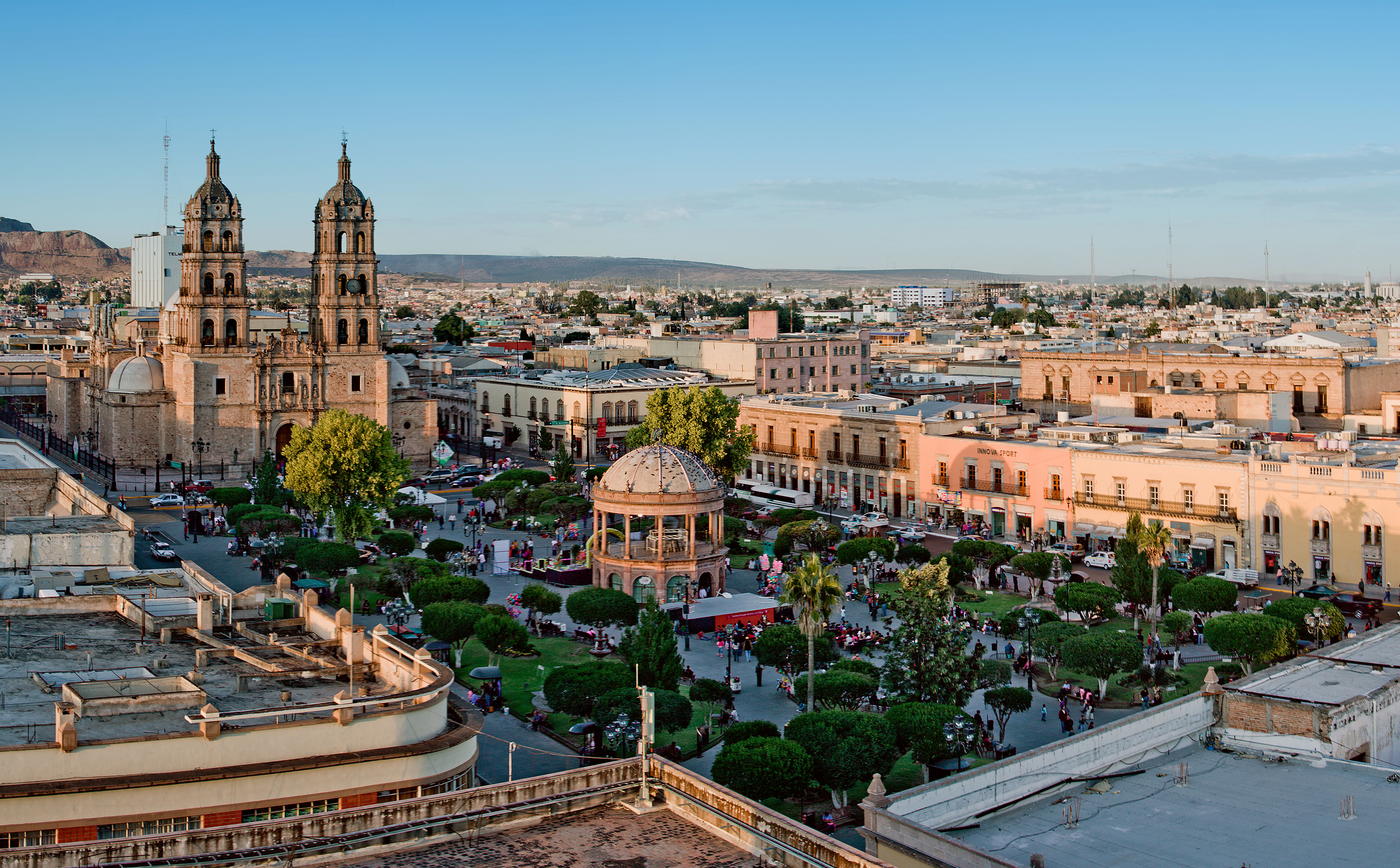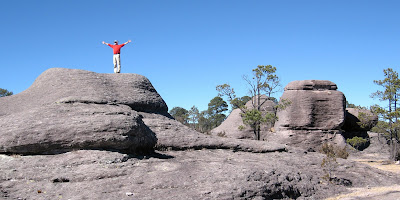I had been harbouring a desire to go inland (beaches are fine, but are they what Mexico is all about??). We decided to rent a car and explore Durango and it wasn’t because any of us had a burning desire to go to Durango – we just all wanted a different experience and Durango happened to be the most convenient. My job was to do the research and organize some potential activities.
What I remembered about this town was that it had something to do with westerns - something to do with John Wayne. These memories were somewhere in my distant past and possibly connected to black and white Saturday afternoon TV programs from the early 60’s. I was right. Durango is the western movie capital of the world, famous for such films as The Magnificent Seven, The Wild Bunch and True Grit.
A more recent movie to be filmed there was Bandidas with Penelope Cruz and Salma Hayek in 2006.
Incredible. But old cowboy movies will not show us what Mexico is all about. Westerns were made by Hollywood looking for “authentic” scenery – we were looking for something more fundamental, something more defining, something that might be entirely Mexican.
I burrowed away in the internet and discovered that Highway 40 – the only road that connects Durango to the Coast – has two nicknames – “The road of 3000 curves” and, the more sinister: “The Devil’s Spine”.
I, who have travelled thousands of miles on twisty, windy roads on a Japanese rice rocket, had seen nothing like it. I, who lives in the mountainous British Columbia, had never seen anything like it. The names described it exactly, for the twists were so acute, trucks could not round the corners without driving into the other lanes, passengers had to take precautions to prevent car sickness, and the 180 mile drive took 8 hours to complete. Here's a couple YouTube videos to give you a taste: http://www.youtube.com/watch?v=wYAdpnFfDPE and http://www.youtube.com/watch?v=GlD3OEI0E3Q
Okay, so the road was twisty. Big Deal. Why the “spine”? Well, imagine the road of 3000 curves and add a gradual elevation from sea level to 8200 feet meandering over (not through) a huge series of crevices that rival the American “Grand Canyon”.

When the trucks come into your lane to make the corner and you move over to make room, you notice the pavement has given away to a precipice. In a tiny 1.2 litre Renault, this isn’t a comforting place to be. Happily for us, Paul is an excellent driver, and we survived our journey.
Devil's Spine Lookout near the summit
These spectacular rock formations line the summit of the Devil's Spine
Trucks probably should not be on this road, but it is the only connection between Durango and the sea. As we went along, we saw there is a massive undertaking to create tunnels and bridges to straighten the road and shorten the trip. With the through traffic on the new road, the Spine could turn out to be the best bike ride ever!
Happy Biker in earlier days
Travelling the road was very exciting, but the stops we took were also wonderful. Forty kilometers out of Mazatlan we stopped at Copala. This little village, perched at 1600 feet in the foothills of the Seirra Madres, has a cobbled track the visitor follows for about a kilometer before reaching the bougainvillea covered walls of the village.
Bougainvillea lined streets

Don Francisco de Ibarra
In truth, he had noticed the natives laden with silver and was led to the area as the source for their ornamentation. Throughout its history the town has generated silver from various mines and was used in experiments by the Butters company to extract the metal with the use of cyanide. Great way to get silver, but very bad for the environment. This method was soon abandoned and all that remains of the Butters company is an abandoned cafe.
Butter no more!
There is a gorgeous, very old little church in the town plaza with beautiful views of the hills around.
Church of St. Joseph, built in 1748
Who is this figure overlooking the entry?
Side view from inside the church reveals the rolling hills
Copala Town Plaza
A couple of locals have little kiosks selling small wooden carvings of the place and pieces of raw silver. In an old, rustic hotel called “Daniels”
Daniel's Restaurant/Hotel
then wandered around in the shafts of an abandoned silver mine below the restaurant.
Laura and Paul descend into the depths of the mine shaft below the restaurant
Exiting the mine

Beautiful Copala nestled in the hills
As we continued to climb the Devil’s Spine we encountered evidence of the new road – fantastic bridge structures and tunnels through massive mountains.

Obviously the highway is employing hundreds of people and there is a lot of activity in the villages and small towns found along the way. Additionally, as the hills turn in to mountains, the cactus gives way to pine forests, so that in addition to mining, there is a large forest industry.
We arrived in Durango late in the afternoon. As we drove toward the centre of the city along tree lined boulevards we realized this was no cowboy town. Durango is a thoroughly modern, cultured and urbane place with hundreds of years of history under its belt.
Cathedral spire overlooking plaza

Theatre - view from Paul and Laura's room
A 19th century palace, now shops and cafes
Beautiful old hotels can be found all around the plaza, as well as pedestrian walkways, a huge public market and street after street of stores and cafes.
Pedestrian walkway
We felt totally under and inappropriately dressed in our beach wear and sandals as we checked into our hotel. We had forgotten, though we should have known, that just because the peso has a lousy exchange rate against the dollar, doesn’t make it any less valuable to those who use it within their economy. For example, a teacher in BC might make $4000.00 a month and, when they go to Victoria and stay in a hotel, they pay anywhere from a very, very cheap $50.00 a night at a roadside motel, to $120.00 (on special) at one of the boutique hotels (such as Swan’s) downtown, to $200.00 or more, a night at the Empress. In Mexico, a teacher may make $1000.00 a month and stay in an inexpensive hotel in Durango for $25.00, medium priced $35.00 and over $100.00 for the best. So, my long winded point is, that we, as Canadians, can afford to stay in the best hotels in Mexico for a fraction of the price we would pay at home, even though we are on a professional par in our respective societies.
Roma Hotel
We stayed at the Roma Hotel and, after checking out a half dozen of their rooms, settled on two of their better ones – both with king sized beds and a complete bathroom. Paul and Laura’s room was on the top floor, corner room, and had two balconies that looked over the city, as well as a small sitting area. Ours was on the second floor and featured a large bay window, some interesting architecture and cathedral ceilings.
Interesting archway in the room
We paid approximately $50.00 and $45.00 respectively. It was the first time we had slept in a real bed in almost six months!
While in Durango we enjoyed several nice meals. The town is famous for “Caldillo Durangueno” which is a type of beef stew with chiles.
Caldillo Durangueno
Laura had it one night and wasn’t overly impressed. However, that could be because the rest of us were savouring thick Angus steaks grilled on a hot plate. One of our favourite experiences was stopping at a local restaurant on a Friday afternoon and watching it slowly fill up with locals and their families celebrating the end of the week. The place was beautifully appointed, musicians began to play, the sound of happy people surrounded us and we felt pretty good about being a part of that scene. In fact, the whole time we were in Durango we only saw one other gringo couple. Finally, we were getting a chance to see how Mexicans lived without the influence of touristas.

Beautiful downtown Durango
We spent most of our two days there wandering the streets and boulevards, gardens and plazas, watching the people around us living their lives. The time flew by and before we knew it we were back in the little Renault, once again, bombing down the Devil’s Spine. This time we stopped at the Park Natural Mexiquillo and hiked about 5 kilometers along a 16 kilometer unused railway bed, through forests of pine, unusual rock formations, breathtaking views and waterfalls.
Mexiquillo cabins
Hiking along a railway line that was never built
Waterfalls at the driest time of the year
View from waterfall - at the bottom of the picture is a drop off where the falls continue. At the top of the picture you can just see a wire - it's a zip line for the more adventurous explorers!
It's not hard to feel you are on top of the world at about 7000 feet!
Unusual rock formations in a windswept plateau























Wow! What a trip. It looks like you had a great time exporing the highlands. It's great seeing some high altitude photos.
ReplyDeleteGreat blog. I think I am going here a.s.a.p. !
ReplyDelete